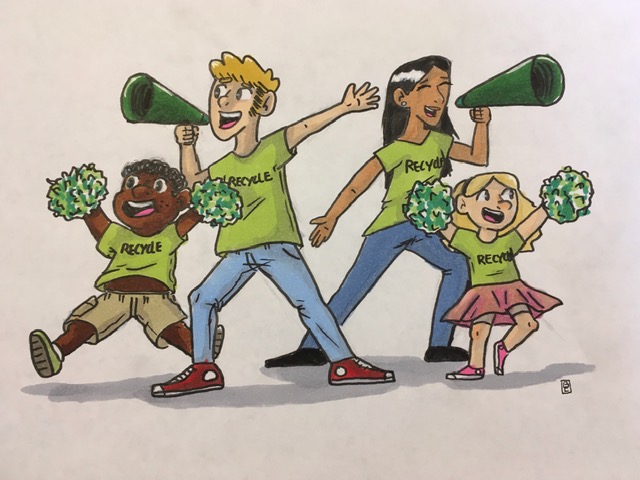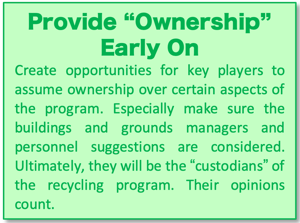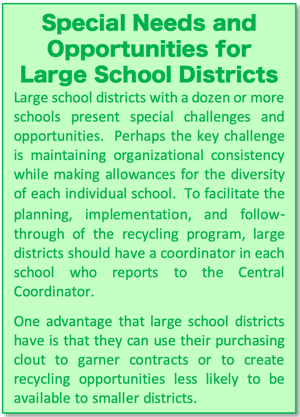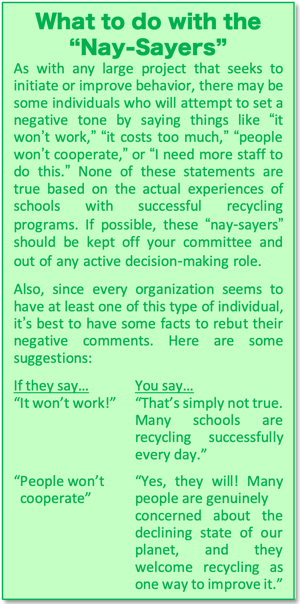
Phase Two: Build a Team
 Your Recycling Team should consist of a small group of people who will collect data, provide input, design and implement the recycling program, as well as teach students and staff how the new system works. Aim for a team of at least 4-5 people including buildings and grounds and food service staff or contractors, since these departments may be managed by outside contractors.
Your Recycling Team should consist of a small group of people who will collect data, provide input, design and implement the recycling program, as well as teach students and staff how the new system works. Aim for a team of at least 4-5 people including buildings and grounds and food service staff or contractors, since these departments may be managed by outside contractors.
You’ll need to designate a champion, lead or “central coordinator” for the Recycling Team. The Central Coordinator will facilitate the entire process and communicate progress and challenges to the decision-makers. There are many candidates, including the school district business manager, a principal, or a teacher. This person must be given the authority by the principal or superintendent to advance the project. It is vital for the Central Coordinator to know the schools well.
A list of all key personnel who will be involved with the program at different phases is provided below with descriptions for each person’s role in the recycling program, regardless of whether or not each person is actually a member of the “Recycling Team.”
Some suggestions for whom to include on the Recycling Team follow:
click the titles below for more information
 Key Role: To assume responsibility for facilitating all aspects of program design and implementation; to be the central contact and point person for the program.
Key Role: To assume responsibility for facilitating all aspects of program design and implementation; to be the central contact and point person for the program.
Responsibilities:
- Organize a Recycling Team.
- Conduct waste audits.
- Design program for the school(s).
- Facilitate implementation of program.
- Ensure that materials are monitored for quality control.
- Track amount of material(s) recycled.
- Reinforce program through continuing educational and promotional efforts.
- Serve as point person for the program.
- Explore ways to improve and/or expand programs.
Checklist:
- Review this toolkit and the linked resources.
- Organize Recycling Team.
- With superintendent, meet with principals to discuss program logistics and develop preliminary timeline.
- Ask principals to alert buildings and grounds and food service staff/contractors about program and upcoming waste audit.
- Perform waste audits.
- Complete program design, including list of recyclables to be collected, container needs, cost assessment and collection and storage requirements.
- Confirm that school officials and haulers/recyclers have determined frequency of pickup and type of storage containers for each school.
- Identify educational and promotional needs and set program kickoff date.
- Communicate information about program to all principals, school personnel,* parent-teacher associations and other appropriate persons/groups;* e.g., the athletic director who must be familiar with recycling in areas such as gymnasiums and outdoor playing fields.
- Meet with student environmental clubs and/or other appropriate personnel to discuss potential kickoff events and other educational projects. Also, try to involve students who are not necessarily involved with the environmental club, such as athletes, band members, members of the school newspaper staff, and several key teachers in order to appeal to all of the student body, especially if an assembly is planned.
- Contact school district communications personnel to discuss writing an article about the program to be published in the local paper or posted on the municipality’s or the school district’s website. (NOTE: A series of articles can trace the program from planning through implementation, related student projects, and long-term results of program.)
- Remind hauler of kickoff date and double-check collection schedule.
- Assure that all collection containers within the school are in place (with trash and recycling containers next to each other), signs and posters are mounted, and student/teacher monitors understand their roles.
- Ask that teachers discuss recycling and environmental issues with classes to give students background on why recycling is important.
- Ask superintendent or principal to send an email to parents reaffirming the school’s commitment to recycling.
- Coordinate a school assembly or other event to kick off the recycling program.
 Create a poster (possibly using the school district’s/school’s mascot) for use throughout the district. See the popup box explaining the recycling symbol and an example of the creative use of the symbol to customize a logo.
Create a poster (possibly using the school district’s/school’s mascot) for use throughout the district. See the popup box explaining the recycling symbol and an example of the creative use of the symbol to customize a logo.- Disseminate announcements via school radio/Cable TV, website, social media pages and email messages.
Key Role: Provide support for the program at the administrative level. Work closely with Central Coordinator to communicate with school principals the importance of their involvement in planning and monitoring the program. Serve as a central link for gathering and disseminating information among the schools and to the community.
Responsibilities:
- Meet with Central Coordinator to introduce program to school principals and buildings and grounds managers.
- Speak in support of school recycling program at appropriate kickoff events.
- Offer to serve as contact or designate a contact for local media if needed during kickoff events.
- Help motivate staff and students to participate in program.
- Disseminate information as program progresses.
Key Role: Generate enthusiasm and support for the new recycling program within the school. Act as the Central Coordinator, or work closely with that person to communicate the school’s recycling needs and to disseminate information.
Responsibilities:
- With the Central Coordinator, select a start-up date for the new recycling program.
- Participate in a waste audit to assess the school’s recycling needs.
- Keep the school’s program visible: arrange for a school wide assembly on the kickoff day; set recycling goals for students and offer incentives (such as free ice cream) if the goals are met; make recycling a recurrent school theme (through assembly programs, reminders about the program on morning announcements, and local field trips to recycling centers or landfills).
Key Role: Act as Central Coordinator, or work with that person when contracting for recycling and/or trash collection services. Help establish budget for collection containers and promotional efforts.
Responsibilities:
- Review data compiled from walkthrough assessment.
- Review existing trash/recycling collection/hauling contracts.
- Include request for recycling service in next hauling bid (remember to be specific), or re-negotiate contract with current hauler to include recyclables.
- If outdoor storage containers will be provided by the hauler, work with school buildings and grounds managers and personnel to be sure each school receives the proper size. Also, make sure all containers arrive in time for the program kickoff.
- Review staff job descriptions to assure that recycling requirements are incorporated.
- Be available for feedback from schools once recycling program begins.
- Make adjustments in storage containers or frequency of pickups if necessary.
- Establish central data collection system to record amounts collected.
- Annually report amounts of materials recycled to local recycling officials, or be sure that the recycling hauler does so and also sends the school district copies of tonnage reports.
Checklist:
- With the assistance of the Central Coordinator, compile walkthrough assessment information and determine overall school district recycling needs.
- Review existing trash/recycling hauling contract.
- Include a list of desired recyclables and volume estimates in the next hauling bid, or discuss needs with the current hauler.
- Monitor the delivery of any outdoor storage equipment provided by the hauler.
- In consultation with the buildings and grounds manager, purchase any recycling containers needed.
- Check with schools once the program begins to be sure the new recycling service meets the needs of each school.
Key Role: Stay up-to-date on the school district’s recycling plans, and provide any assistance possible.
Responsibilities:
- Update school board members and/or Parent/Teacher Association members of program status.
- Assist school in obtaining corporate sponsors for the recycling program.
- Offer to write or call local business contacts to spread the word about the school district’s recycling efforts.
- Speak at kickoff events.
(This representative may be the Buildings and Grounds Superintendent, the Facility Director, the Head Custodian or someone else from this department. Some schools have their own employees that fill these rolls or contract with a company for these services.)
Key Role: Assist with implementing and maintaining the new recycling program, and serve as school contact for discussions with the trash hauler.
Responsibilities:
- Watch this video: Getting Started in Frankford: School and Municipality Work Together.
- Cooperate with the Central Coordinator, principal and other school personnel to conduct a school walkthrough assessment.
- Help determine size and quantity of recycling containers needed in classrooms, cafeterias and other locations (e.g. offices, gymnasiums, and outdoor athletic fields) and types of containers needed for transport from inside locations to outside dumpsters. Be sure that all containers are properly labeled.
- Work out a schedule for the school’s internal flow of recyclables based on the trash hauler’s collection schedule.
- Familiarize yourself with the hauler’s expectations and standards for recyclables.
- Put recyclables into the proper storage containers.
- Provide the final quality control, check for the school’s recyclable material. If recyclables are particularly contaminated, notify the Central Coordinator.
- Monitor the program logistics such as the size of outdoor storage units and the frequency of pickups by the trash hauler.
Checklist:
- Assist with the school’s walkthrough assessment.
- Work with other key personnel to determine the size and quantity of recycling containers needed throughout the school.
- Obtain a recycling pickup schedule from the district’s hauler.
- With the Central Coordinator, create and distribute a school collection schedule for all recyclables.
- Provide ongoing quality control for all recyclables by monitoring collection containers.
- Ensure that recyclables are prepared properly (e.g., there should be no recyclables inside plastic bags).
- Report any problems with the size of storage containers or frequency of pickups by the hauler to the business administrator or Central Coordinator.
Key Role: Facilitate the collection of recyclables from the kitchen and lunchroom.
Responsibilities:
- Provide information about recyclables found in the kitchen and cafeteria for the school’s walkthrough assessment.
- Help determine the number and the placement of recycling containers necessary for the kitchen and cafeteria; e.g., if trash containers are available at each end of the cafeteria, recycling containers should be placed next to the trash containers.
- Educate food service managers and personnel about the program’s requirements; enlist their cooperation.
- If food service personnel act as cafeteria monitors, make sure they understand contamination issues and monitor students’ placement of recyclables in containers.
Checklist:
- Provide a list of recyclables and volume estimates for the school’s walkthrough assessment.
- Assist with the placement of recycling containers in the cafeteria, and ensure that proper signage is on both the recycling and trash containers.
- Instruct staff on how to participate in the program in the kitchen and how to monitor students in the cafeteria (if applicable).
Key Role: Educate students about the environment. In addition, exude enthusiasm for the program (be a recycling cheerleader). It’s critical to give students positive feedback about their recycling efforts.
Responsibilities:
- If the school does not have an environmental club, form one. Give the club members a special title (such as the “Green Team”), and invite students to actively plan and support the recycling program.
- Organize the environmental club into a team of student monitors. The club can check paper collected in the classrooms and monitor recycling in the cafeterias. If necessary, the club can organize a rotating schedule of classrooms to assist with program monitoring.
- Use available recycling projects and curricula to educate students about the environment. Be sure to emphasize that a daily recycling effort by students can add up to a significant savings in landfill space in just one school year.
- In elementary schools, involve students in promoting the recycling program by making posters for the classroom, hallways or cafeteria. Challenge other classes to a paper collection contest.
- Keep parents informed about the school’s program via school newsletters, cafeteria menu, letters sent home with students, or posting on the school district’s website.
- If teachers have cafeteria duty, they could monitor students and recycling containers to prevent potential contamination.
- Use recycling as a fun, educational opportunity (e.g., as a math activity, record weight of the collected materials) and incorporate into math, science and other curricula. See the Resources section below.
- Refer to the NJ Clean Communities Best Practices Manual for lists of books, assembly programs and curricula.
Checklist:
- Form a student environmental club or support the efforts of an existing club by encouraging students to join.
- Involve your students in monitoring the recycling program.
- Have your students make posters, visit younger students to discuss recycling, or promote the new program in other ways.
- Watch this this video about DeMasi Middle School students assisting the elementary school students. DeMasi Middle School is located in Marlton, NJ. This video is part of a video playlist created for schools by ANJR.
- Educate students about the environment, especially during week of program start-up.
- Monitor students’ participation and quality of recyclables in the classroom and cafeteria.
Key Role: Become involved in the recycling program as much as possible by source separating materials, monitoring materials for contaminants, promoting the program, and spreading the word about your school’s environmental effort.
Responsibilities:
- Become part of the Recycling Team by forming or joining a school environmental club or working with administrators to implement the program at your school.
- Set up a student monitoring schedule to be sure classroom and cafeteria recycling containers are not being contaminated with trash.
- Volunteer to talk about the recycling program on the school morning announcements. Here’s an example: Video on Trash Talk Announcements at DeMasi School.
- Keep other students enthusiastic about recycling through a school poster contest, classroom challenges, or articles in the school publications. See some ideas in this video about DeMasi Middle School students assisting the elementary school students.
 Checklist:
Checklist:
- Join the school environmental club. If the school doesn’t have a club, form one.
- Assist in the collection of materials from classrooms, where appropriate.
- Set up a student monitoring schedule for all recyclables collected in classrooms and cafeterias.
- Promote the new recycling program:
- Design a school recycling mascot (this could be related to a school mascot already in existence).
- Create a recycling information and display board.
- Challenge other classrooms to collection and quality control contests.
- Hold a school poster contest.
- Write articles about the importance of recycling for the school publications.
- Tell your parents or guardians and siblings about the recycling program.

Municipal and/or County Recycling Coordinator
Once the team is established, hold a meeting that includes a discussion with your municipal and/or county recycling coordinator regarding an overview of recycling requirements, available recycling markets and collection options. Each municipality and county in the State has a recycling coordinator. You may find these people in your municipality or county to be very helpful. Throughout this toolkit, there are suggestions for ways in which municipal and county recycling coordinators may be particularly helpful.
The Recycling Symbol
 The recycling symbol, according to Wikipedia, is “…one of the most readily recognizable logos in the world.” Learn more from Wikipedia about the recycling symbol and Gary Anderson, its creator.
The recycling symbol, according to Wikipedia, is “…one of the most readily recognizable logos in the world.” Learn more from Wikipedia about the recycling symbol and Gary Anderson, its creator.
The recycling symbol has been used in numerous publications, as well as on recycling containers and promotional materials. One such example is this logo from Vineland, NJ, located in Cumberland County. Grapes have been grown in the Vineland area for many years, and Welch’s (now known as Welch Foods Inc.), a producer of grape juice, grape jam, etc., was founded in Vineland. As one can see, the recycling symbol appears in upside-down fashion with a bunch of grapes inside – a very creative combination of the symbol and the grape-growing industry that has been so important in Vineland. Using the recycling symbol creatively as it relates to your school recycling program is highly recommended.


